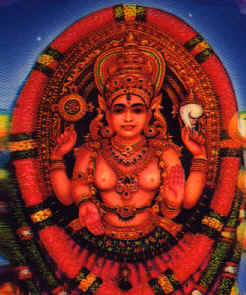Chottanikkara
enshrines Bhagawati - the mother Goddess, one of the most popular deities in Kerala. The
town of Chotanikkara is located near the city of Ernakulam. Enroute is the Poornatrayesa
temple at Tripunittura.

The Deity:
Rajarajeswari is the presiding deity here. The image of Bhagawati (Rajarajeswari) is of
laterite; untouched by the human sculptor, this image is of irregular shape. and is
covered with a golden kavacam. The image has four arms. The upper right holds the discus,
the left a conch. This deity is worshipped in three different forms - as Saraswati in the
morning - draped in white, as Bhadrakali at noon draped in crimson, and as Durga in the
evening decked in blue.
Adjacent to this image in the sanctum
is an image of Vishnu in granite. Vishnu and Bhagawati together are referred to as
Lakshminarayana. The prayers here address the deity as Amme Narayana, Devi Narayana and
Lakshmi Narayana.
Interestingly, the image here is not
fixed to the ground and is mounted on loose sand. Water offered during ablution ceremonies
percolates underground.
There is also a shrine to Sastha
depicting him with his consorts Purna and Pushkala. In front of the shrine are the
flagstaff and the bali pitham. To the south is a platform known as Pavazhamallithara
where the deity is believed to have appeared first. To the south west is a shrine to
Shiva. To the north east there is a flight of steps leading to the Keezhkaavu,
a shrine to Bhadrakali.
In the keezhkaavu shrine is a paala
tree with hundreds of nails driven into its trunk, as a mark of devotees having been
exorcised here. Worship here is believed to rid devotees of evil influences, psychological
ailments, evil spirits etc.
Much of the structure in this temple
is a result of renovation carried out by the government of Cochin, in late 19th century.
Legend has it that a
ferocious dacoit by name Kannappan who dominated this area, brought home a cow with the
intent of slaughtering it. The cow escaped his butchering knife, and set him running in
hot pursuit. His chase in vain, Kannappan returned home to find his beloved daughter
playing with the very same cow. Complying with her request, he forsake the idea of killing
the cow. His daughter passed away, and this greatly grieved him. Goddess Bhagawati
appeared in his dream, and revealed to him that it was she who had come to him in the form
of a cow. To his surprise, he saw two images in the cowshed the following day; the images
were those of Devi and Vishnu. Kannappan built a humble shrine and worshipped the images
in the cowshed. Eventually this shrine fell under repair and was discovered later and
sanctified. It then grew into a shrine of the magnitude seen today, over a period of time.
The annual festival
here is celebrated in the month of Kumbha or Aquarius (Feb - Mar). Maasi Makam, coinciding
with the full moon, during this festival attracts vast crowds. Legend has it that the
deity appeared in front of Vilvamangalam Swamigal a saint associated with this shrine and
with Guruvayur. Vilvamangalam Swamy is said to have discovered Bhadrakali enshrined
in Keezhkaavu.
